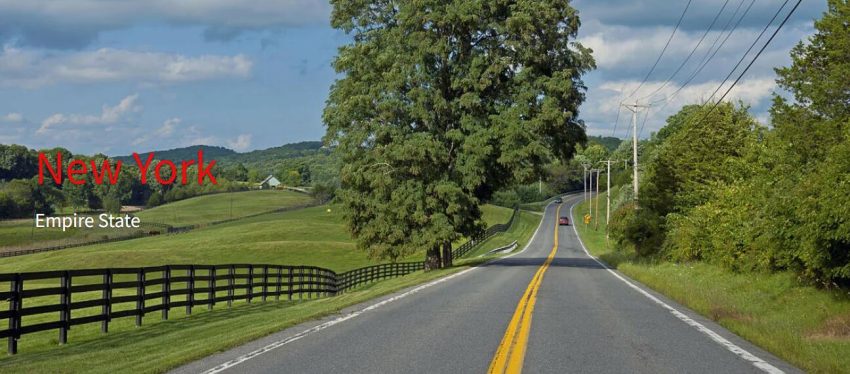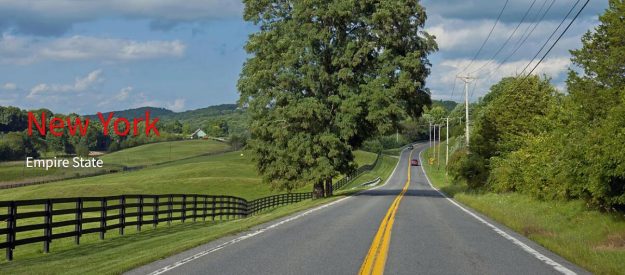Information New York
New York, abbreviation NY, is the name of one of the states of the United States of America and at the same time the name of the largest city in this state. By the way, New York City is not the capital of New York State, which is Albany. New York’s nickname is “the Empire State”.
The state borders on Canada, among others. The main attractions of New York State is of course New York City, also known as “the Big Apple”.
New York is the largest city in the United States and one of the largest and most important cities in the world. The city has 9.5 million inhabitants and consists of five boroughs, namely Manhattan, Brooklyn, the Bronx, Staten Island and Queens. Manhattan is the center of the city. See all cities in New York.
The main attractions of New York are the Statue of Liberty, the Empire State Building and Wall Street. You can also visit a number of parks, including the famous Central Park. Of course there are also many cultural excursions possible in New York. For example, visit Broadway or the Metropolitan Museum of Art.
Geography
New York belongs to the northeastern United States, but is not considered part of the New England region. The state is located on the Atlantic Ocean, as well as on the border with Canada (Ontario & Québec). It further borders the states of Vermont, Massachusetts, Connecticut, New Jersey and Pennsylvania. The state is divided geographically into Upstate New York, which comprises the majority of the state, and ‘Downstate’, which comprises the conurbation around New York City. Mainland New York has only a short coastline with the Atlantic Ocean, but the elongated Long Island results in a long coastline.
In the northeast of the state are the Adirondack Mountains, a mountain region with peaks between 1,000 and 1,500 meters that is sparsely populated and densely forested. The 1,628 meter high Mount Marcy is located here and is the highest point in the state. The Catskill Mountains separate Upstate from Downstate and are a forested mountain range with peaks up to 1,200 meters. Elsewhere in the state, large valleys alternate with hill country. The major rivers are the St. Lawrence on the border with Canada, the Hudson River on the southeast, and the Delaware River on the border with Pennsylvania. Famous are the Niagara Falls on the border with Canada, which connect the large lakes Lake Erie and Lake Ontario. In addition, New York has the so-called ‘Finger Lakes’ in the middle of Upstate New York, a number of elongated lakes southwest of Syracuse. The large Lake Champlain forms part of the border with Vermont. In addition, there are numerous smaller lakes in the state, including a number of reservoirs.
History
After Verrazano had already discovered New York harbor in 1524, it was not until 1609 before another European ship entered. Henry Hudson then sailed in Dutch service up the river later named after him to the vicinity of present-day Albany. He gave the whole area the name New Netherland. In 1614 a first Dutch settlement, Fort Nassau, arose, in 1624 also a near Albany, Fort Oranje. In 1625 and 1626, the colonization of Manhattan began, the beginning of New Amsterdam. In 1629 the West India Company introduced a special system of large land ownership, the patronage: whoever could establish a settlement in the new area with fifty adult settlers was given an extensive piece of land along the river. In this way powerful estates arose and an aristocratic element developed,
The history of the Dutch colony is one of many failures. Governor Minuit was recalled in 1631, because he gave in too much to the bosses, who were already in conflict with the company. Governor Wouter van Twiller (1633–1638) promoted trade, but also his own interests and was therefore succeeded by Willem Kieft (1638–1647), who in 1643 started a war with the Indians, causing great damage to the colony. The last Dutch governor, Petrus Stuyvesant (1647–1664), ruled vigorously and headstrong, bringing him into conflict with the citizens. He conquered (1655) the Swedish colony on the Delaware, defeated the tribes in the north in a second Indian War, but had to surrender the entire colony himself to the English Colonel Richard Nicholls, who, by order of the Duke of York (later King James II, to whom his brother Charles II had given the area) occupied the area and changed the name to New York. The Dutch element continued to play an important role and in 1673/1674 the colony was briefly in Dutch hands again.
Under the English rule, a system of greater freedom slowly grew. The colony became deeply involved in the ongoing wars between England and France in the 18th century. Although New York’s merchants vehemently opposed English taxes after the Seven Years’ War, New York played no major role in the American Revolutionary War. Still, it sent delegates to the Continental Congress (1775), while its own provincial congress passed the Declaration of Independence and passed a Constitution for the state. In 1778, New York became the 11th state in the Union.
New York politics, long dominated by the aristocratic families, underwent a vigorous democratization in the new Constitutions of 1821 and 1846. As a Democratic candidate, Martin Van Buren became the first New Yorker to be elected president in 1836. Although there were many abolitionists in New York and the Republican party flourished there after its foundation in 1856 under the capable leadership of William Henry Seward, there was quite a lot of opposition in the state and especially in New York City to participation in the American Civil War, fearing damage to trade. After that, New York experienced a tremendous boom through immigration and industrialization, but the associated urbanization and corruption led to major problems. Time and again, however, the state proved to have capable reformers at its disposal,
Economy
Economically, the state is dominated by the city of New York. Industry is the most important sector. Nearly all industries are represented within state borders. In addition to New York, major industrial centers include Buffalo (Kodak factories), Schenectady, Rochester, Syracuse, and Yonkers. Trade and services are also important economic activities. The state is an important transportation hub: the Mohawk Valley provided opportunities to traverse the Appalachian Mountains.
After being the principal agricultural area of the United States in the 19th century, this function has diminished in importance with the rise of the western states. Agriculture now has a nurturing function for the large cities on the coast; As a result, the importance of dairy production (accounting for more than 50% of the value of total agricultural production), horticulture and fruit growing is particularly significant. The main minerals are sand and gravel, salt, zinc, petroleum and natural gas.
| Abbreviation: | NY |
| Nickname: | Empire State |
| Joined the US as e at: | 26 July 1788 |
| Capital city: | albany |
| Census: | 19.465.197 |
| Surface: | 141.205 km² |
| Geography: | Bordering Canada, Vermont, Massachusetts, Connecticut, New Hampshire and Pennsylvania |
| Governor: | Andrew Cuomo |
| state motto: | Ever upward |
| California official website: | ny.gov |
| Capital city: | Raleigh |
| Census: | 9.656.401 |
| Surface: | 139.509 km² |
| Geography: | Bordering Virginia, South Carolina, Georgia and Tennessee |
| Governor: | Roy Cooper |
| state motto: | To be rather than to seem |
| California official website: | nc.gov |

